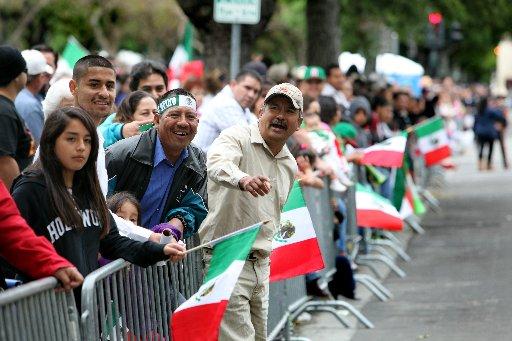By Frances J. Vasquez | SCNG Contributing Columnist
During the social and political turmoil of the U.S. Civil Rights movement in the 1960s and 1970s, the Cinco de Mayo holiday was a rallying cry for Chicanos and symbolic of resistance to systemic discrimination and oppression of Mexicanos/Latinos giving rise to Chicano power and identity.
Dr. Lily Rivera’s essay, “Cinco de Mayo: A Battle for Recognition” summarizes the basis for the celebrations, “… American citizens who have been marginalized socially and economically, a people who have had to wrench their rights and privileges from an unwilling populace through the force of law… who, until only the most recent of times, were not included in this country’s history books.”
Why do we celebrate a Mexican battle? UCLA Distinguished Professor David E. Hayes-Bautista suggests in his book, “El Cinco de Mayo: An American Tradition,” that ultimately it emerges as an important American holiday with roots in the Civil War, and connects an emergent Mexican-American identity with the social and political turmoil of the U.S. during the 1860s.
France launched an invasion of Mexico in 1861 when Napoleon III blamed Mexico’s suspension of debt payments (associated with Mexico’s war of independence from Spain) for the aggression. But his imperialistic goals became clear. French troops marched from the Gulf of Mexico intent on conquering the city of Puebla en route to the capital. Instead, Mexican General Ignacio Zaragoza led a valiant defense of Puebla on May 5, 1862 and defeated the invaders. The victory temporarily halted the French, yet it held immense symbolism for Mexicanos and Latinos in California.
At the outbreak of the U.S. Civil War, California’s diverse population included native-born Californios, Mexicans, Cubans and other Spanish-speaking peoples. Hayes-Bautista said the many “juntas” (meetings) held in California before the Civil War found common cause and identity by their support of a democratic Mexico and an emancipated U.S. When Latinos in California received news of the Mexican victory at Puebla, Spanish-language newspapers throughout the state rejoiced. People halted their work and held fiestas with fireworks, music, and patriotic speeches.
The juntas raised money to help Mexico and continued the annual observance of May 5 in California. By commemorating the Mexican resistance to French intervention on Cinco de Mayo, Mexicanos and Latinos in California found a cause that celebrated both ethnic solidarity and their loyalty to the United States.
Growing up in Highgrove in the 1950s, our parents took us to Cinco de Mayo fiestas in Colton. These were fun, family-friendly celebrations featuring music, food, snow cones, mariachis, “danzantes” and games. Kids joyfully smashed colorful “cascarones” (confetti eggs) on each other’s heads. Adults enjoyed socializing and visiting vendor booths.
Related Articles
A chat with Dave Prinz of Amoeba Music, the world-famous indie-record store
Two charged with cutting down famous tree in England
Taliban turn their attention to wooing tourists to Afghanistan
Humanity’s soundtrack: How music has influenced society and what it means to be human
Firefighters contain destructive fire on historic California pier
Longtime friend Jennie Gracia Espinosa phoned to say that she had sorted through several boxes of Chicano cultural memorabilia belonging to her late daughter, Adrienne Gracia. When Jennie offered her collection to me, I felt as if I hit the jackpot!
Reality set in and I suggested that she donate the materials to Jorge Hernandez, her former North High School student and Adrienne’s friend. He is an avid Chicano culture aficionado and would make excellent use of the materials. “Just let me keep the Cinco de Mayo poster,” I said. “You got it!” Jennie replied.
The poster is beautiful and in mint condition from being stored in its original mailing tube. I unfurled the large poster to see a colorful image of two radiant folkloric “danzantes” dancing “el Jarabe Tapatio” — the Mexican Hat Dance. It depicts a 32-cent commemorative postage stamp the United States Postal Service issued in April 1998 in San Antonio, Texas. Three inspirational words are inscribed at the bottom: Pride, Determination, Achievement. Indeed, when considering the implications of the battle of Puebla, one can imagine the indomitable spirit of the Mexicanos (4,500 strong) defending their turf against an invasion of Napoleon III’s 8,000 troops — valiantly winning the battle — like David against Goliath.
Significantly, the Cinco de Mayo stamp was designed by Californians, Carl Herrman of Laguna Niguel and illustrated by Robert Rodriquez of Pasadena. This was the first stamp that the USPS ever shared with another country. One week after the release of the U.S. stamp, Mexico issued its version using the same art.
The Postal Bulletin of March 12, 1998 states, “The stamp is a salute to the holiday Cinco de Mayo. The origins of Cinco de Mayo date back to Mexico’s victory over French invaders at the Battle of Puebla on May 5, 1862. In the United States, Cinco de Mayo celebrations symbolize national self-determination for Mexican-Americans and solidarity within the Latin-American community.”
The significance of Cinco de Mayo in California has evolved and endures as an important reason to celebrate the pride, determination, and achievement of Mexicanos and Latinos. As Hayes-Bautista wrote, “It continues to reflect the aspirations of a community that is engaged, empowered, and expanding.” Gracias, Jennie, for bringing Adrienne’s iconic poster to light and for validating what it truly represents.
Frances J. Vasquez is director emerita of Inlandia Institute and facilitates Tesoros de Cuentos Workshops.


